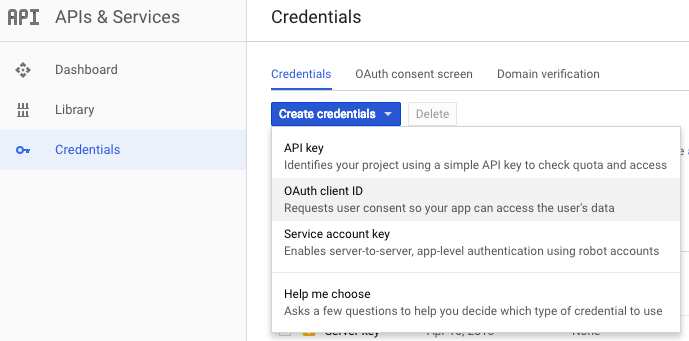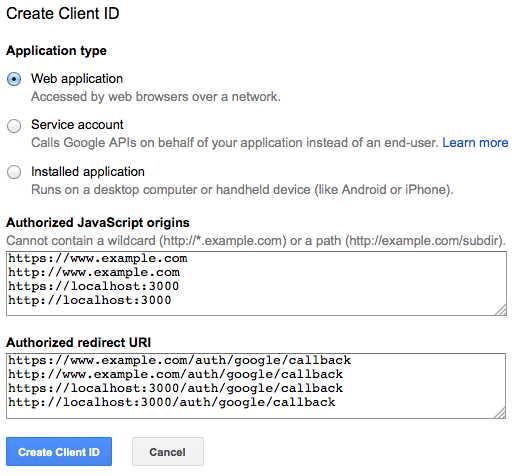Ecosyste.ms: Awesome
An open API service indexing awesome lists of open source software.
https://github.com/garu/dancer-plugin-auth-google
Authenticate your Dancer app with Google
https://github.com/garu/dancer-plugin-auth-google
Last synced: 11 days ago
JSON representation
Authenticate your Dancer app with Google
- Host: GitHub
- URL: https://github.com/garu/dancer-plugin-auth-google
- Owner: garu
- License: artistic-2.0
- Created: 2014-04-20T07:20:18.000Z (over 10 years ago)
- Default Branch: master
- Last Pushed: 2019-02-28T21:09:21.000Z (almost 6 years ago)
- Last Synced: 2024-11-05T21:50:33.621Z (about 2 months ago)
- Language: Perl
- Size: 212 KB
- Stars: 0
- Watchers: 3
- Forks: 3
- Open Issues: 3
-
Metadata Files:
- Readme: README.md
- Changelog: Changes
- License: LICENSE
Awesome Lists containing this project
README
Dancer-Plugin-Auth-Google
=========================
[](https://api.travis-ci.org/garu/Dancer-Plugin-Auth-Google.png)
[](https://coveralls.io/r/garu/Dancer-Plugin-Auth-Google)
[](http://badge.fury.io/pl/Dancer-Plugin-Auth-Google)
This plugin provides a simple way to authenticate your users through Google's
OAuth API. It provides you with a helper to build easily a redirect to the
authentication URI, defines automatically a callback route handler and saves
the authenticated user to your session when done.
```perl
package MyApp;
use Dancer ':syntax';
use Dancer::Plugin::Auth::Google;
auth_google_init; # <-- don't forget to call this first!
get '/' => sub {
if (session('google_user')) {
return 'you are logged in, ' . session('google_user')->{name};
}
else {
return redirect auth_google_authenticate_url;
}
};
get '/fail' => sub {
"Oh, noes! Your authentication failed :("
};
```
Prerequisites
-------------
In order for this plugin to work, you need the following:
### Session backend ###
For the authentication process to work, **you need a session backend** so the plugin
can store the authenticated user's information.
Use the session backend of your choice, it doesn't make a difference, see
[Dancer::Session](https://metacpan.org/pod/Dancer::Session) for details
about supported session engines, or search the CPAN for new ones.
### Google Application ###
Anyone with a valid Google account can register an application. Go to
http://console.developers.google.com, then select a project or create
a new one. After that, in the sidebar on the left, select "Credentials".
First, go to the *OAuth consent screen* tab and set it up with you website's
logo, desired credentials (the "email" and "profile" ones are granted
by default) and, specially, your **authorized domains**. We'll need those for
the next step!
Now go to the *Credentials* tab and click the **Create credentials**
button/dropdown and select **OAuth client ID**.

A dialog will appear. In the "Application type" section of the dialog,
select *"Web application"*.
Under the "Authorized JavaScript origins" field, put the domains of both
your development server and your production one
(e.g.: http://localhost:3000 and http://mywebsite.com). You will only be
able to include domains listed under your *authorized domain list*,
which you set on the previous step (though localhost domains are ok).
Same thing goes for the "Redirect URIs": those **MUST** be the same
as you will set in your app and Google won't redirect to any page that
is not listed (don't worry, you can edit this later too).

Again, make sure the "Redirect URIs" contains both your development
url (e.g. C) and production
(e.g. C). It's usually a good
practice to add I HTTP and HTTPS callback urls.
After you're finished, copy the "Client ID" and "Client Secret" data
of your newly created app. It should be listed on that same panel
(you can check it anytime by going to the "Credentials" option)
### Configuration ###
After you set up your app, you need to configure this plugin. To do
that, copy the "Client ID" and "Client Secret" generated on the
previous step into your Dancer's configuration under
Plugins / Auth::Google, like so:
```yaml
# config.yml
plugins:
'Auth::Google':
client_id: 'your-client-id'
client_secret: 'your-client-secret'
scope: 'profile'
access_type: 'online'
callback_url: 'http://localhost:3000/auth/google/callback'
callback_success: '/'
callback_fail: '/fail'
legacy_gplus: 0
```
Of those, only "client_id", "client_secret" and "callback_url" are mandatory.
If you omit the other ones, they will assume their default values, as listed
above.
Specifically, it is a good practice to change the "callback_url" depending on
whether you're on a development or production environment. Dancer makes this
trivial by letting you split your settings, leaving the basic plugin
settings on "config.yml" and specific "callback_url" definitions on
"environments/development.yml" and "environments/production.yml":
```yaml
# environments/development.yml
plugins:
'Auth::Google':
callback_url: 'http://localhost:3000/auth/google/callback'
```
And
```yaml
# environments/production.yml
plugins:
'Auth::Google':
callback_url: 'http://myproductionserver.com/auth/google/callback'
```
#### Setting your permissions' scope ####
Since this plugin is meant mainly for authentication, the default scope
is 'profile'. That should give you general profile data for the user, such
as full name, id, profile url, etc. See
https://developers.google.com/identity/protocols/googlescopes for available
scopes to chose from. You can set as many as you like, separated by space.
A usual combination is 'profile email'. If you want a Google-specific scope
(i.e. those with a "." in the name) make sure you add the full URL as
specified in the link above. For example, the proper way to ask for
restricted Google Drive access is "https://www.googleapis.com/auth/drive.file",
not just "drive.file".
### Installation ###
cpanm Dancer::Plugin::Auth::Google
Exports
-------
The plugin exports the following symbols to your application's namespace:
### auth_google_init ###
This function should be called before your route handlers in order to
initialize the underlying object and set up the proper routes. It will
read your configuration and create everything that it needs.
### auth_google_authenticate_url ###
This function returns an authorize URI for redirecting unauthenticated
users. You should use this in a before filter like the "synopsis"
demo above.
Google allows you to send additional `key=value` data to preserve state
in your application throughout the OAuth2 process, via the *state* variable.
To do so, simply tweak the URI object with that additional info:
```perl
use URI::Escape;
if (!session('google_user')) {
my $state = 'CSRF=my-special-token&other=whatever';
my $uri = auth_google_authenticate_url;
$uri->query_form(
$uri->query_form, # <-- required so we ADD instead of REPLACE
state => URI::Encode->new->encode($state),
);
return redirect $uri;
}
```
If you do this, the "state" data will be sent back to you on the callback
as a request parameter. You can then use it to direct your user to the
proper resource or check it against forgery attacks - assuming you also
stored it in a session variable of some sort.
Route Handlers
--------------
The plugin defines the following route handler automatically:
* /auth/google/callback
This route handler is responsible for catching back a user that has just
authenticated herself with Google's OAuth. The route handler saves tokens
and user information in the session and then redirects the user to the URI
specified by callback_success.
If the validation of the token returned by Google failed or was denied,
the user will be redirected to the URI specified by callback_fail. Otherwise,
this route will point the user to callback_success.
### What data is under session('google_user')?
After getting basic authentication data, this module uses the Google Identity
Platform API, to fetch basic user profile data, like a unique id, email, name
and picture. `session('google_user')` looks like so (random hash order!):
```perl
{
access_token => 'THIS IS THE ACCESS TOKEN TO USER',
expires_in => 3920, # seconds!
token_type => 'Bearer',
refresh_token => 'USE THIS TO REFRESH ACCESS WITHOUT NEW AUTH',
name => "FirstName LastName",
given_name => "FirstName",
family_name => "LastName",
picture => "https://SOME-GOOGLE-URL/photo.jpg",
locale => "en",
gender => "female", # or "male", or "other"
email => "[email protected]",
link => "https://OLD-GOOGLE-PLUS-PROFILE-THIS-MIGHT-GO-AWAY",
id => "NUMERIC UNIQUE USER ID HERE",
hd => "HOSTED DOMAIN",
verified_email => 1,
}
```
##### NOTE: G+ is no more. Add 'legacy_gplus: 1' to keep old code running.
Up to version 0.06 of this module the `session('google_user')`
data structure was as returned by Google Plus' API. Google decided to
discontinue G+ and its API on March 7th 2019, so since version 0.07
we fetch user information from Google's `oauth2/v2/userinfo` endpoint.
Those two structures are very different, so
**you will need to update your code** if you used any version of this module
prior to 0.07. If you don't want to, add the `legacy_gplus` option to
your configuration with a true value and `session('google_user')` will instead return
a data structure as closely matched as possible to the old version.
Note that some data may not be available anymore (particularly,
*circleByCount* and *etag*), in which case the structure
will return `undef` - but you tested those fields already, right?
Accessing Other Google APIs
---------------------------
Once the user is authenticated, your session data will contain the access
token:
```perl
my $token = session('google_user')->{access_token};
```
You can use that access token to make calls to a Google API on behalf of
the user. See https://developers.google.com/identity/protocols/OAuth2WebServer
for more information on this.
Acknowledgements
----------------
This plugin was written following the same design as
Dancer::Plugin::Auth::Twitter and Dancer::Plugin::Auth::Facebook.
COPYRIGHT AND LICENCE
---------------------
Copyright (C) 2014-2019, Breno G. de Oliveira
This library is free software; you can redistribute it and/or modify
it under the same terms as Perl itself.